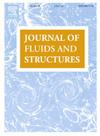用粘弹性材料抑制柔性板的冲击振荡
IF 3.4
2区 工程技术
Q1 ENGINEERING, MECHANICAL
引用次数: 0
摘要
研究了结构粘度对正态激波与柔性板间流固耦合作用的影响。两个兼容面板的设计允许显著的静态变形,同时表现出不同的动态行为。为此,根据其在冲击振荡频率范围内的动态响应,使用了两种不同的弹性体材料:聚氨酯40A用于弹性面板,Tango Polyjet 61A用于粘弹性面板。动态力学分析表征了材料的动态特性,从而能够评估两种结构的固有振动模式和频率。弹性板的固有振动频率与冲击波的固有振动频率一致。风洞实验表明,弹性板与激波之间存在强烈的动力耦合,当激波集中在弹性板上时,弹性板会产生大幅度的同步振荡。相反,粘弹性面板的设计避免了弹性面板中观察到的流固耦合。材料显著的粘弹性将固有振动模式转移到更高的频率,超出了冲击波的固有振动范围。因此,在与激波的相互作用中,粘弹性板只表现出较大的静态变形——大于弹性板的静态变形——而与激波位置无关,没有任何动态流固耦合。这些发现表明,粘弹性材料在流动控制应用中具有巨大的潜力,可以提供结构阻尼和频率相关的刚度,有效地将静态变形与动态相互作用解耦。我们的研究结果表明,粘弹性面板可以优化为冲击控制的自适应凸起,在不引起不必要的动态耦合的情况下响应流体动力学。本文章由计算机程序翻译,如有差异,请以英文原文为准。
Suppressing shock-induced oscillations of a compliant panel with viscoelastic materials
The influence of structural viscosity on the fluid–structure interaction between a normal shock-wave and a compliant panel is investigated. Two compliant panels are designed to allow significant static deformation while exhibiting different dynamic behaviors. For this purpose, two distinct elastomeric materials are used based on their dynamic responses within the shock oscillation frequency range: polyurethane 40A for the elastic panel and Tango Polyjet 61A for the viscoelastic panel. Dynamic mechanical analyses characterize the materials’ dynamic properties, enabling the evaluation of natural vibration modes and frequencies of both structures. The elastic panel exhibits natural vibration frequencies that align with the ones of the natural oscillations of the shock-wave. Wind-tunnel experiments reveal strong dynamic coupling between the elastic panel and the shock-wave, leading to large-amplitude, synchronized oscillations when the shock is centered on the panel. In contrast, the viscoelastic panel is designed to avoid the fluid–structure coupling observed in the elastic panel. The marked viscoelastic properties of the material shift the natural vibration modes to higher frequencies, outside the shock-wave’s natural oscillation range. As a result, in its interaction with the shock-wave, the viscoelastic panel exhibits only a large static deformation – greater than that of the elastic panel – without any dynamic fluid–structure coupling, regardless of the shock position. These findings demonstrate that viscoelastic materials hold significant potential for flow control applications, providing structural damping and frequency-dependent stiffening, which effectively decouple static deformation from dynamic interaction. Our results suggest that viscoelastic panels could be optimized as adaptive bumps for shock control, responding to fluid dynamics without inducing unwanted dynamic coupling.
求助全文
通过发布文献求助,成功后即可免费获取论文全文。
去求助
来源期刊

Journal of Fluids and Structures
工程技术-工程:机械
CiteScore
6.90
自引率
8.30%
发文量
173
审稿时长
65 days
期刊介绍:
The Journal of Fluids and Structures serves as a focal point and a forum for the exchange of ideas, for the many kinds of specialists and practitioners concerned with fluid–structure interactions and the dynamics of systems related thereto, in any field. One of its aims is to foster the cross–fertilization of ideas, methods and techniques in the various disciplines involved.
The journal publishes papers that present original and significant contributions on all aspects of the mechanical interactions between fluids and solids, regardless of scale.
 求助内容:
求助内容: 应助结果提醒方式:
应助结果提醒方式:


